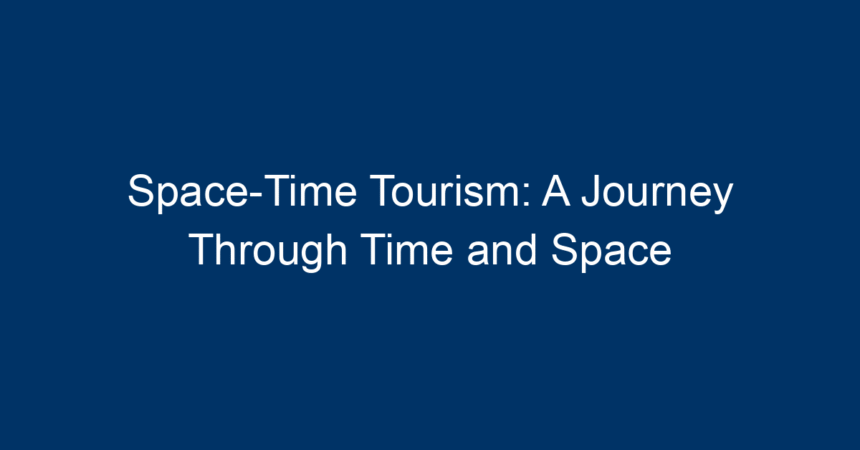In the not-so-distant future, the concept of traveling through both space and time may no longer be confined to the realm of science fiction. Welcome to the exhilarating world of space-time tourism—a groundbreaking vision of adventure that offers a mesmerizing blend of exploration beyond our planet and journeys to significant moments in history. Imagine stepping into a vessel designed to traverse the cosmos while simultaneously gliding through the fabric of time. In this article, we will delve into the possibilities, technologies, and ethical considerations surrounding this fascinating new frontier.
What is Space-Time Tourism?
Defining Space-Time Tourism
Before we set off on our journey, it’s essential to clarify what space-time tourism entails. Unlike traditional tourism, which focuses solely on geographic relocation, space-time tourism encompasses both dimensional travel through space and temporal travel through past and future epochs. This futuristic adventure could allow tourists to visit historical events, witness the emergence of civilizations, or even experience moments yet to come.
Historical Context
The fascination with time travel is as old as humanity itself, with countless tales spun in literature and cinema. From H.G. Wells’ "The Time Machine" to modern blockbusters like "Interstellar," the allure of maneuvering through time has sparked imaginations for generations. As space exploration began to take shape in the 20th century, the groundwork for time travel theories emerged, intertwining the two concepts in an exciting tapestry of potential experiences.
The Science Behind Space-Time Travel
Understanding Space-Time
At the heart of space-time tourism is the theory of relativity introduced by Albert Einstein. According to this revolutionary concept, space and time are interwoven, creating a four-dimensional continuum. Consequently, the idea of traveling through both space and time hinges on bending or manipulating this continuum in ways we are only beginning to understand.
Theoretical Frameworks
While time travel remains speculative, physicists have proposed several theoretical methods. Some offerings include:
- Wormholes: Hypothetical passages through space-time, wormholes could serve as shortcuts, allowing travelers to bypass traditional spatial limitations while venturing into different temporal realms.
- Time Dilation: The effects of gravity and velocity can affect time perception, according to Einstein’s theories. This means that by traveling at near-light speeds, one could theoretically experience time at a different rate than those remaining stationary.
- Cosmic Strings: These theoretical 1-dimensional defects in the fabric of space-time may, in theory, allow for time manipulation if appropriately harnessed.
Technologies on the Horizon
Emerging technologies in quantum mechanics and gravitational physics could one day pave the way for space-time tourism. Research into quantum computing, advanced propulsion systems, and general relativity is advancing rapidly. Companies like SpaceX and Blue Origin have already made strides in space travel; combining these efforts with time manipulation technology is the next big leap.
The Experience of Space-Time Tourism
A First-Person Perspective: What to Expect
For those lucky enough to experience space-time tourism, the offerings would be limitless. Imagine stepping aboard a sleek spacecraft that transports you to significant historical events. Would you choose to witness the signing of the Declaration of Independence or see the first lunar landing?
-
Historical Sightseeing: Picture yourself standing amid the bustling streets of ancient Rome or walking through the first market in Mesopotamia. Space-time tourism could allow tourists to immerse themselves fully into different epochs.
- Future Experiences: Venturing into the future, tourists might gain insight into technological marvels and societal forms yet to evolve. Would you want to take a deep dive into the environmental challenges of the next century?
Emotional Engagement
Space-time tourism isn’t just about observation; it’s about emotional engagement. The thrill of standing in the presence of historical figures or feeling the weight of a significant moment in time is unparalleled. By blending sensory experiences with significant historical narratives, travelers can gain a profound understanding of humanity’s evolution.
Challenges and Ethical Considerations
The Paradoxes of Time Travel
While the concept of space-time tourism is thrilling, it comes with inherent challenges and ethical dilemmas. One of the most famous paradoxes, the “grandfather paradox,” raises questions about the implications of altering past events. What would happen if a time tourist accidentally changed something monumental?
- Temporal Invariance: Many theories suggest that time is immutable, meaning any attempts to change the past would either fail or result in a timeline that branches into a parallel universe.
- Ethical Questions: If time travel becomes a reality, questions of ethical responsibility arise. At what point does observation become interference?
Safety Concerns
Safety is another glaring concern when it comes to space-time tourism. The technology required for such journeys would need rigorous testing and assurance that it would not pose risks to human life or the integrity of time itself.
Regulation and Governance
Just as with space travel, the advent of space-time tourism would necessitate robust regulations. International agreements and frameworks would be crucial to ensure ethical practices and safety measures, which could take years to establish.
The Future of Space-Time Tourism
Current Initiatives and Research
While actual space-time tourism is still a dream, numerous initiatives and research projects are laying the groundwork. Startups specializing in advanced propulsion systems and quantum mechanics are prophesying a new age of exploration.
Public Perception and Acceptance
Public fascination with space tourism is already evident, as evident in the success of private spaceflight companies. Awareness and education regarding time travel could further enhance interest and acceptance in the years to come.
Call for Investment
As research evolves, investment in both technological and theoretical frameworks will be key. Encouraging public and private funding can help accelerate the journey toward making space-time tourism a reality.
Conclusion: Taking the First Steps into the Unknown
As we stand on the precipice of what could be one of humanity’s most exhilarating adventures, the concept of space-time tourism invites excitement mixed with caution. While challenges and ethical considerations loom, the potential for profound experiences beckons.
The intersection of space exploration and time travel might seem distant, but by fostering innovation, open discussions, and rigorous exploration, we can turn this dream into a tangible reality. Let’s invest in our future and imagine a world where we not only explore the stars but also touch the very fabric of time itself.
The journey of space-time tourism promises to be an unforgettable chapter in the story of humanity. After all, the stars and time itself await our exploration—what better time to imagine our future than now?




